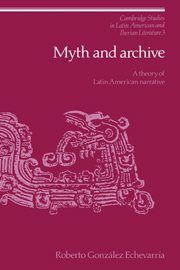6 results in Cambridge Studies in Latin American and Iberian Literature

Miguel Angel Asturias's Archeology of Return
-
- Published online:
- 04 February 2010
- Print publication:
- 30 July 1993

Spanish Romantic Literary Theory and Criticism
-
- Published online:
- 02 November 2009
- Print publication:
- 12 December 1991

Journalism and the Development of Spanish American Narrative
-
- Published online:
- 08 October 2009
- Print publication:
- 26 November 1993

At Face Value
- Autobiographical Writing in Spanish America
-
- Published online:
- 14 September 2009
- Print publication:
- 22 February 1991

Myth and Archive
- A Theory of Latin American Narrative
-
- Published online:
- 12 September 2009
- Print publication:
- 28 September 1990

The Spanish American Regional Novel
- Modernity and Autochthony
-
- Published online:
- 08 September 2009
- Print publication:
- 24 November 1989

